provided by John Phillips
Mike Cockerham of Oglethorpe, Georgia, is a member of the Mossy Oak ProStaff. As a regional manager, he oversees Georgia, Florida, North Carolina and South Carolina. Cockerham started hunting feral hogs because of necessity. “I had to figure out a way to get rid of wild pigs before they destroyed everything I owned.”
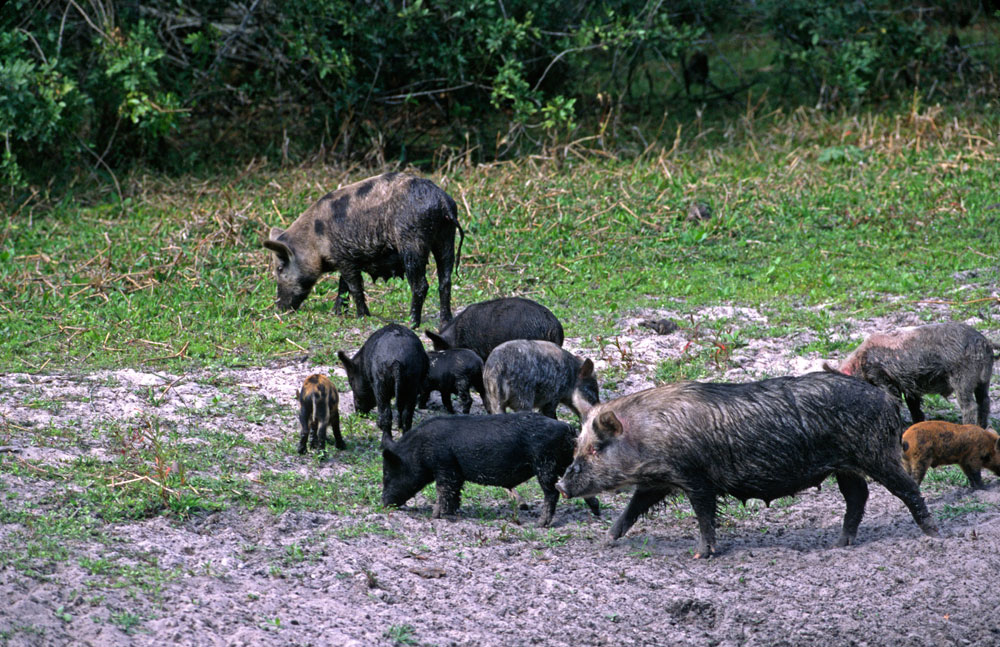
Mike Cockerham Today Primarily Hunts Wild Pigs at Night
Back then I was farming, but now I'm farming trees. When I was farming agriculture on about 500 acres, feral hogs totally would destroy whatever crop I had planted. These feral hogs would eat up my soybeans down to their roots. I probably have been hunting hogs now for at least 15 years, and in the last two years, I've started hunting those hogs at night. I’ve found that taking wild hogs at night is much easier than it is during the day. I have a 300 Blackout AR-15 rifle that was designed by Remington to create a reliable compact .30 caliber round for the AR platform. I put a Pulsar thermal riflescope with 4–12X (power) on it. But I never use the 12X on the scope, because I like to get up close and personal to the hogs. I've had this setup for about a year: I shoot 110-grain Hornadays with an SST bullet that’s really hard hitting. If I don't put the hogs down with a head or a neck shot, and the hogs start running, I aim for any place I can hit on the hog.
I'm often asked, “How do you know where the hogs are that need to be taken,” and I answer, “I look for fresh rootings.” I see about 100 hogs just about every night on my property each year, until I've gotten them somewhat under control.” I kill about 60-plus hogs during 50 or 60 nights of hunting them. But I've changed my tactics now. I've put out a deer feeder, and the hogs come to that feeder. I'm also going to start trapping the hogs to try and control them. I’ll use a corral-type trap and a Hog Slammer gate. The hogs will go in the gate, and I’ll have a trigger placed in the back of the trap where I’ve put out corn. Once the hogs reach the back of the trap, the trigger will shut the gate. The most hogs I've ever called into a trap is about 10 and is the best way I know of to catch a massive number of hogs in the least amount of time.
Cockerham Helps Neighbors with Feral Hog Problems
When I hunted feral hogs for 45 to 50 days a year, I started in December and hunted every night until the end of March. During the day, I’d go out and look for fresh rootings where the earth had been turned over and looked moist. Then that night, I'd return to that same spot and start shooting hogs. Although some nights they wouldn't be at those rooting sites, most nights they would be. The most wild hogs I ever took in one night was five. A strange thing that happened when I shot hogs over fresh rootings one night was then the next night, more hogs would seem to come to those same fresh rootings. They will be rooting around grass or out in the soybean patches.
Many of my neighbors had and still have the same problems I do with hogs rooting up their crops and eating their crops, but they don't try and control them like I do. So, I inherit their hogs as well as the hogs that are living on my place. My neighbors will ask me to come over to their fields and shoot the hogs out of their soybean and peanut fields. I'll start watching their fields and shoot wild hogs out of them pretty quickly. Before we get into the heat of the summer, I only hunt for a couple of hours when I go out at night. A good, average night will be my taking two to three hogs. I'm operating under a crop-depredation permit due to the feral pigs ruining crops and tearing up roads in our section of Georgia. In Georgia, we have to leave the hogs where they fall after we shoot them.
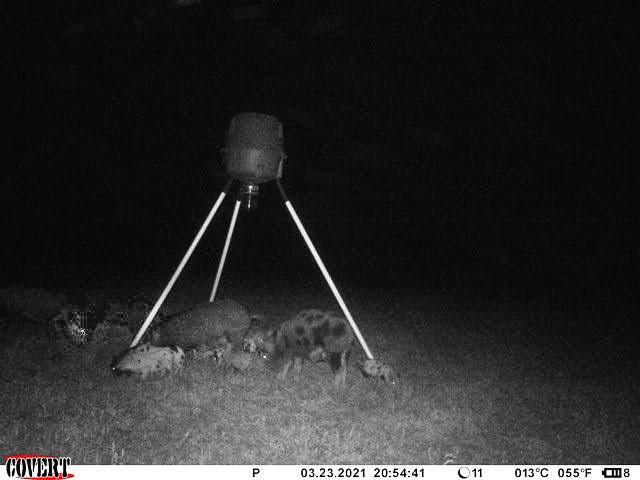
Using a Feeder to Take Feral Hogs
Before I started hunting wild hogs at night with a thermal-imaging riflescope, I either would put out corn or set up a feeder and then sit in a deer stand and shoot wild pigs when they came to the feeder. I only have one corn feeder right now, and it's close to the gate of my corral trap for wild pigs. The hogs tend to stay close to the feeder, so they can hear it when it goes off. Usually they'll come to the feeders 5 - 10 minutes before the timer is set to go off, which is usually an hour or two before daylight or an hour or two before dusk. Some really thick undergrowth is right by the feeder. I know the pigs have to be within 100 yards of that feeder to be able to hear it go off.
My minimum take for a month is 25 or 30 wild hogs off that same feeder within a month, although wild hogs usually won't return to the feeder for about a day or two. However, those feral pigs can't stand not to have that delicious sweet corn that’s in the feeder to eat. So, reason plays no place in the wild pig’s brain. That feeder with corn in it is tied to their bellies. If you set the time for the feeder to go off during daylight hours, then you can see the feral hogs when they come, and you can shoot them. Most often I’ll set my feeder to go-off about an hour before dark, and those wild hogs generally will come in before the feeder goes off. The hogs will be in front of the feeder, waiting on the feeder to start slinging corn, so they can start eating. That's the way I first started shooting hogs, and I would use a .308 or a .270 rifle.
When I’m near a feeder, I usually can get one wild hog when the wild hogs are standing still and feeding on the corn. But after the shot, the hogs will start running. That's how I learned how to shoot hogs while they were running. I'm often asked how I aim at a wild hog and hit it when it's running. I lead the hogs, just like I will lead a dove coming into a field. I usually aim right at the tip of the hog’s nose and squeeze the trigger. The bullet generally will enter in either the neck or the front shoulder of the hog, depending on how fast the wild hogs are running.
The biggest hog I've ever taken was in this past deer season of 2020 and weighed over 300 pounds. I was so glad to take that huge red hog that had killed one of my buddy’s dogs. We were running hogs with dogs, and that hog got the dog on his tusks and killed him. About a week after that, I went to my buddy's place to deer hunt and spotted that red hog. I shot him. I knew that was the same hog - a big, ole boar. He was by himself - not running with any other hogs. I have friends who have dogs, and we'll go out in the daytime or the nighttime and hunt the hogs. I think dogs are one of the best ways to run hogs off a property, at least for a little while. The hogs will stay gone for several days or a week after you run them with dogs, but then they’ll start coming right back.
Hunting Wild Hogs in the Daytime with Dogs
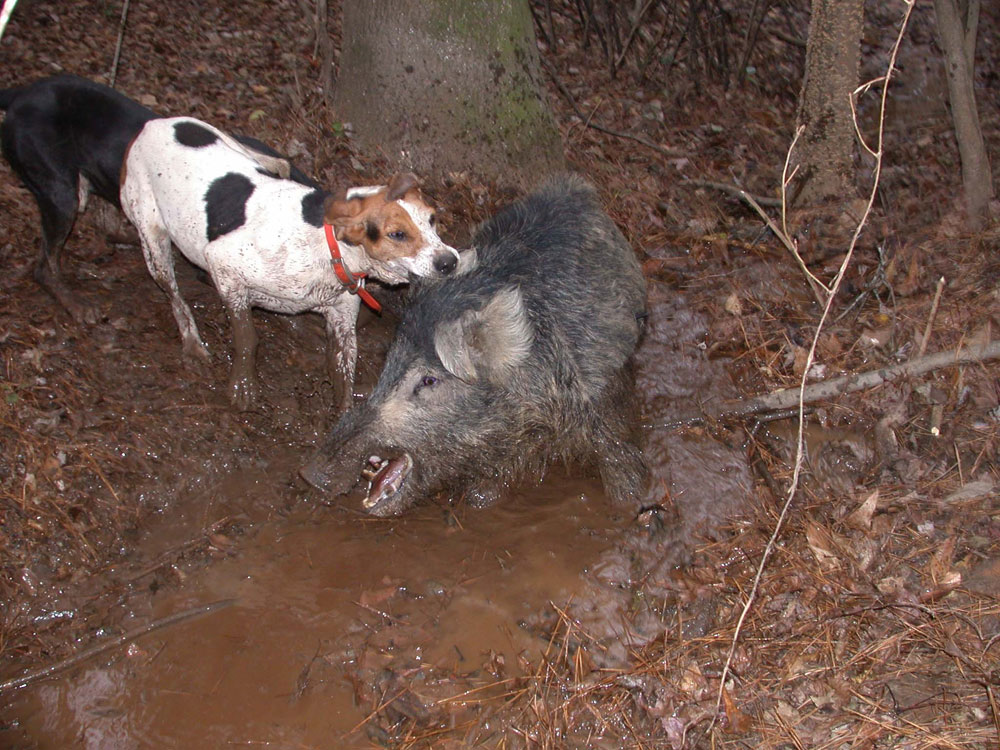
When we hunt with dogs, we mainly hunt with cur dogs that we use as our bay dogs. The curs’ job is to jump the hog and run it until it stops to fight. Then the bulldogs wearing Kevlar vests are turned loose. They’ll grab either an ear or a hog’s jowls and hold it until we get there.
I've seen dogs chase feral pigs around and around in a circle. When we're hunting, we like to hunt wild pigs in the middle of the day when they're bedded down. The dogs will walk around in the woods silently, and once they smell a hog in its bed, the dogs in the pack will circle around the hog. That hog usually will stand there and try to fight the dogs that are barking and snapping at him. However, once the hunters come in, if the bulldogs haven't caught the hog, the hog will break and run, and the chase will be on again.
We’ll turn loose two bulldogs to go in and make the catch, with the biggest hogs generally weighing 175-200 pounds caught with these dogs. If the dogs catch a hog we want to eat, then one of us will go in behind the hog while the bulldogs have it by the jowls and grab its back feet, pick the hog up off the ground, turn it over on its side and tape its back feet and front feet while it's on the ground. Then we'll take a four-wheeler in to the hog and drag it out of the woods with the four-wheeler to the spot where we'll kill and butcher the hog. We'll often use a front-end loader to pull the hog’s feet up in the air, so we can field dress and quarter it.
Usually the fellows who bring the dogs will take the meat because they love to eat it, and they've got friends who love to eat it. I have a friend who takes hog meat and makes sausage out of all the hogs he gets. He uses the hog meat in everything from chili and as sausage to go with grits and eggs. My wife likes that hog sausage my buddy makes.
Thermal Imaging Nighttime Setup for Taking Wild Hogs
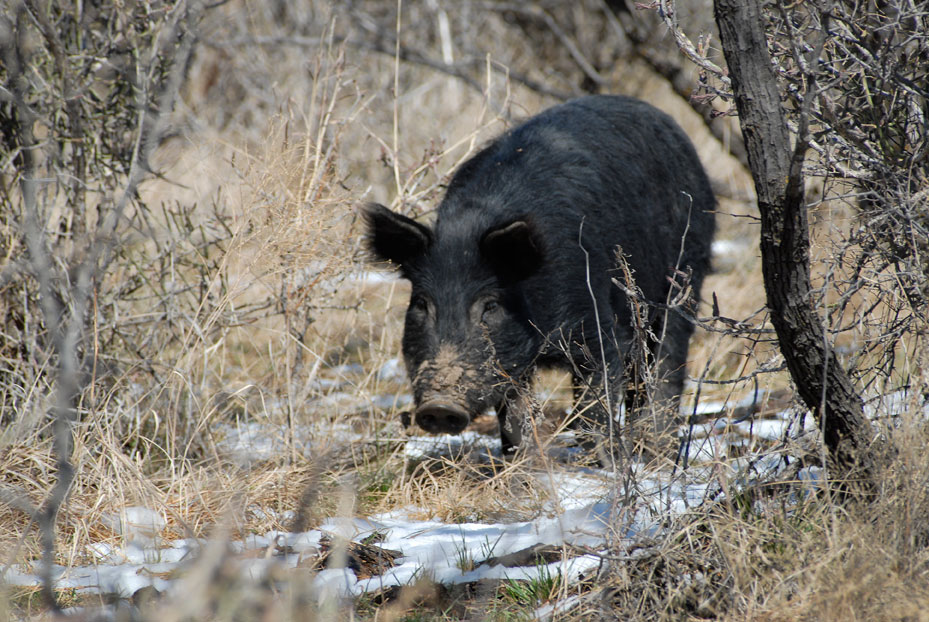
I'm often asked how I got into night hunting hogs. I started hunting hogs at night when I saw how much easier it was to find hogs at night and walk right up on them - perhaps within 30 feet - before you shot them. Most of the time, you either can hear or smell the hogs before seeing them.
Something that helps me at night is my Pulsar thermal monocular, and I can see the hogs at night with that infrared monocular. When I'm approaching the hogs, I stop about 15 or 20 yards out and look at the hogs with the monocular to make sure they haven't moved. Then I ease in alone, until I get right on top of those hogs. This monocular isn’t as powerful as my riflescope – probably about 4X power. But with it, you can see the outline of the hogs and know they're hogs before you walk up to them. I usually can spot the hogs at 300-400 yards and can tell the difference between hogs and a deer by using that monocular. The deer have big, long necks and stand high off the ground. I can see and identify all critters at night – for instance, beavers - with that monocular.
I also have a suppressor (silencer) on my rifle. You have to register that suppressor with the government, because it's a Class 3 item. I'd say I have about $10,000 invested in all my equipment – my AR-15, my thermal riflescope, my thermal monocular and my suppressor. I like a suppressor because it's quiet and doesn't spook as many hogs or scare as many people as if we’re shooting without a suppressor. So, you have to be really serious about the equipment you use at night, if you're going do it and have your own stuff. You’ve also got to keep your wife from getting on to you for spending so much money. Many people buy an outfit like the one I've got and get paid by the numbers of hogs they shoot off farmers’ properties. We have so many places with so many bad hog problems where I live that just about all the landowners around here have a setup like this to try and keep the hogs from eating up everything they've planted.
I got interested in the thermal equipment after going hunting a couple of nights with friends of mine who had thermal sights. I saw how they used them and how effective they were at getting rid of hogs. I decided I had to have a setup like that. I live about 40 miles south of Macon, Georgia, in Macon County. The area I live in is extremely rural, so we don't have a problem with shooting hogs at any time of the year. About a dozen people who live around me hunt hogs at night with thermal scopes and monoculars and AR-15s. Some of those folks also hunt hogs for other farmers and landowners in our region and get paid per hog harvested per night. You quickly can pay off your investment in your rifle, scope, monocular and suppressor, if you live in a place where there's a number of hog problems and landowners who need to get rid of hogs and don't know how to do it themselves. Generally, if you start shooting hogs for farmers, they'll tell other farmers and landowners, and word of mouth will start your business for you.
Another good source for finding hogs at night to hunt is game wardens. Game wardens will know which farmers or landowners are having hog problems. But be sure that hunting wild hogs at night with sights is legal where you live before you try to get into this business or do it for fun. You can check with your local department of Fish and Wildlife and learn the regulations for hunting hogs. Georgia’s Game and Fish Department knows how bad the hog problem is where I live. So, the Department is glad to see us getting rid of as many hogs as we can. Many people kept dogs to hunt and kill hogs in years past. However, now that practice isn’t as popular as it once was.
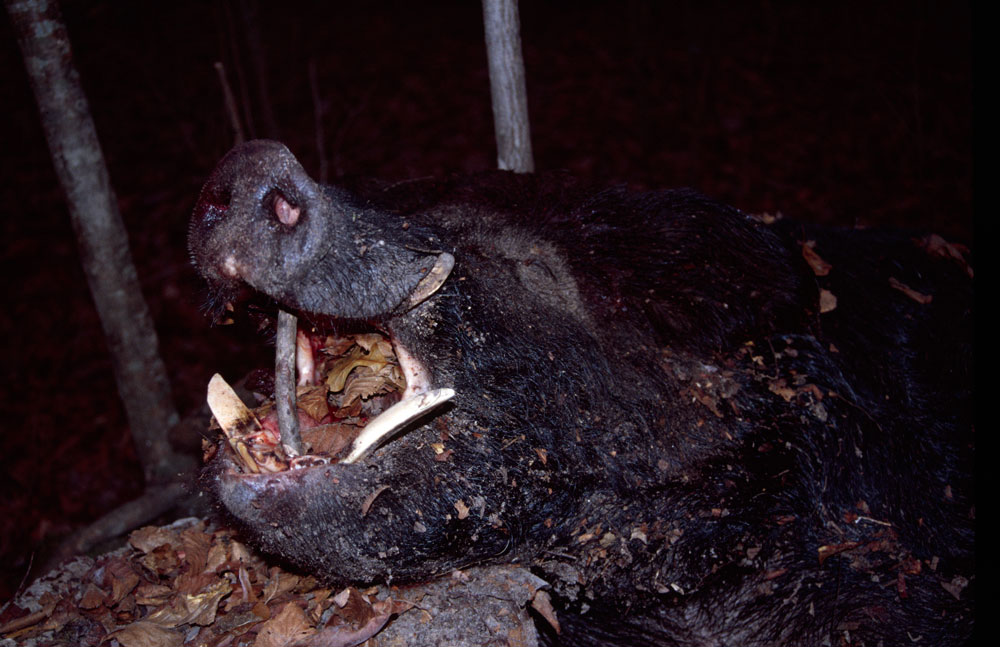
For instance, on my 500 acres, I’ll probably take off 100 wild hogs per year by trapping them and/or shooting them in the daytime and at night. But the next year, there'll be another 100 more hogs I’ll have to trap. Through the winter months until May this year in 2021, I've already killed 60 hogs off my 500 acres. I think the best year I've had was taking about 125 hogs in a year - shooting and trapping the hogs. Hogs are a huge nuisance around where I live, and many larger landowners pay someone to trap and shoot hogs all year long.
Hogs need three things – water, food and bedding areas. So, if you've got food on your land, you will have hogs. If your land has thick places like mine does - I just finished planting a pine plantation - or water, you will have hogs. I've got one cutover place replanted, and the hogs love living in that thick cover that you can't see or get into to get the hogs out. We just have to wait for them to come out of that the cover into the fields where we can shoot them or trap them.
If you're trying to feed deer like we do here in Georgia, you’ve got to make sure your feeders are up off the ground – about 36-inches high. I use a gravity feeder. With a gravity feeder, the deer can stick their noses in that gravity feeder and get to the corn.
Another thing that’s bad about the hogs, besides tearing up your land and eating up your crops, is they will tear up the turkey nests and reduce the number of turkeys you have on your property.



























